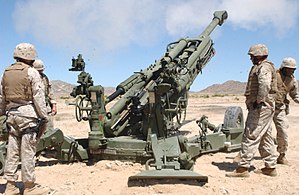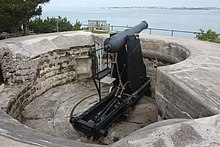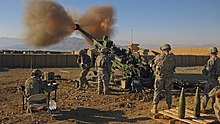
A | B | C | D | E | F | G | H | CH | I | J | K | L | M | N | O | P | Q | R | S | T | U | V | W | X | Y | Z | 0 | 1 | 2 | 3 | 4 | 5 | 6 | 7 | 8 | 9
This article needs additional citations for verification. (June 2022) |

| Part of a series on |
| War Outline |
|---|
 |
Artillery are ranged weapons that launch munitions far beyond the range and power of infantry firearms. Early artillery development focused on the ability to breach defensive walls and fortifications during sieges, and led to heavy, fairly immobile siege engines. As technology improved, lighter, more mobile field artillery cannons developed for battlefield use. This development continues today; modern self-propelled artillery vehicles are highly mobile weapons of great versatility generally providing the largest share of an army's total firepower.
Originally, the word "artillery" referred to any group of soldiers primarily armed with some form of manufactured weapon or armour. Since the introduction of gunpowder and cannon, "artillery" has largely meant cannon, and in contemporary usage, usually refers to shell-firing guns, howitzers, and mortars (collectively called barrel artillery, cannon artillery or gun artillery) and rocket artillery. In common speech, the word "artillery" is often used to refer to individual devices, along with their accessories and fittings, although these assemblages are more properly called "equipment". However, there is no generally recognized generic term for a gun, howitzer, mortar, and so forth: the United States uses "artillery piece", but most English-speaking armies use "gun" and "mortar". The projectiles fired are typically either "shot" (if solid) or "shell" (if not solid). Historically, variants of solid shot including canister, chain shot and grapeshot were also used. "Shell" is a widely used generic term for a projectile, which is a component of munitions.
By association, artillery may also refer to the arm of service that customarily operates such engines. In some armies, the artillery arm has operated field, coastal, anti-aircraft, and anti-tank artillery; in others these have been separate arms, and with some nations coastal has been a naval or marine responsibility.
In the 20th century, target acquisition devices (such as radar) and techniques (such as sound ranging and flash spotting) emerged, primarily for artillery. These are usually utilized by one or more of the artillery arms. The widespread adoption of indirect fire in the early 20th century introduced the need for specialist data for field artillery, notably survey and meteorological, and in some armies, provision of these are the responsibility of the artillery arm. The majority of combat deaths in the Napoleonic Wars, World War I, and World War II were caused by artillery.[1] In 1944, Joseph Stalin said in a speech that artillery was "the god of war".[1]
Artillery piece


Although not called by that name, siege engines performing the role recognizable as artillery have been employed in warfare since antiquity. The first known catapult was developed in Syracuse in 399 BC.[2] Until the introduction of gunpowder into western warfare, artillery was dependent upon mechanical energy which not only severely limited the kinetic energy of the projectiles, it also required the construction of very large engines to accumulate sufficient energy. A 1st-century BC Roman catapult launching 6.55 kg (14.4 lb) stones achieved a kinetic energy of 16 kilojoules, compared to a mid-19th-century 12-pounder gun, which fired a 4.1 kg (9.0 lb) round, with a kinetic energy of 240 kilojoules, or a 20th-century US battleship that fired a 1,225 kg (2,701 lb) projectile from its main battery with an energy level surpassing 350 megajoules.
From the Middle Ages through most of the modern era, artillery pieces on land were moved by horse-drawn gun carriages. In the contemporary era, artillery pieces and their crew relied on wheeled or tracked vehicles as transportation. These land versions of artillery were dwarfed by railway guns; the largest of these large-calibre guns ever conceived – Project Babylon of the Supergun affair – was theoretically capable of putting a satellite into orbit. Artillery used by naval forces has also changed significantly, with missiles generally replacing guns in surface warfare.
Over the course of military history, projectiles were manufactured from a wide variety of materials, into a wide variety of shapes, using many different methods in which to target structural/defensive works and inflict enemy casualties. The engineering applications for ordnance delivery have likewise changed significantly over time, encompassing some of the most complex and advanced technologies in use today.
In some armies, the weapon of artillery is the projectile, not the equipment that fires it. The process of delivering fire onto the target is called gunnery. The actions involved in operating an artillery piece are collectively called "serving the gun" by the "detachment" or gun crew, constituting either direct or indirect artillery fire. The manner in which gunnery crews (or formations) are employed is called artillery support. At different periods in history, this may refer to weapons designed to be fired from ground-, sea-, and even air-based weapons platforms.
Crew
Some armed forces use the term "gunners" for the soldiers and sailors with the primary function of using artillery.

The gunners and their guns are usually grouped in teams called either "crews" or "detachments". Several such crews and teams with other functions are combined into a unit of artillery, usually called a battery, although sometimes called a company. In gun detachments, each role is numbered, starting with "1" the Detachment Commander, and the highest number being the Coverer, the second-in-command. "Gunner" is also the lowest rank, and junior non-commissioned officers are "Bombardiers" in some artillery arms.
Batteries are roughly equivalent to a company in the infantry, and are combined into larger military organizations for administrative and operational purposes, either battalions or regiments, depending on the army. These may be grouped into brigades; the Russian army also groups some brigades into artillery divisions, and the People's Liberation Army has artillery corps.
The term "artillery" also designates a combat arm of most military services when used organizationally to describe units and formations of the national armed forces that operate the weapons.
Tactics

During military operations, field artillery has the role of providing support to other arms in combat or of attacking targets, particularly in-depth. Broadly, these effects fall into two categories, aiming either to suppress or neutralize the enemy, or to cause casualties, damage, and destruction. This is mostly achieved by delivering high-explosive munitions to suppress, or inflict casualties on the enemy from casing fragments and other debris and from blast, or by destroying enemy positions, equipment, and vehicles. Non-lethal munitions, notably smoke, can also suppress or neutralize the enemy by obscuring their view.
Fire may be directed by an artillery observer or another observer, including crewed and uncrewed aircraft, or called onto map coordinates.
Military doctrine has had a significant influence on the core engineering design considerations of artillery ordnance through its history, in seeking to achieve a balance between the delivered volume of fire with ordnance mobility. However, during the modern period, the consideration of protecting the gunners also arose due to the late-19th-century introduction of the new generation of infantry weapons using conoidal bullet, better known as the Minié ball, with a range almost as long as that of field artillery.
The gunners' increasing proximity to and participation in direct combat against other combat arms and attacks by aircraft made the introduction of a gun shield necessary. The problems of how to employ a fixed or horse-towed gun in mobile warfare necessitated the development of new methods of transporting the artillery into combat. Two distinct forms of artillery were developed: the towed gun, used primarily to attack or defend a fixed-line; and the self-propelled gun, intended to accompany a mobile force and to provide continuous fire support and/or suppression. These influences have guided the development of artillery ordnance, systems, organizations, and operations until the present, with artillery systems capable of providing support at ranges from as little as 100 m to the intercontinental ranges of ballistic missiles. The only combat in which artillery is unable to take part is close-quarters combat, with the possible exception of artillery reconnaissance teams.[3]
Etymology
The word as used in the current context originated in the Middle Ages. One suggestion is that it comes from French atelier, meaning the place where manual work is done.
Another suggestion is that it originates from the 13th century and the Old French artillier, designating craftsmen and manufacturers of all materials and warfare equipments (spears, swords, armor, war machines); and, for the next 250 years, the sense of the word "artillery" covered all forms of military weapons. Hence, the naming of the Honourable Artillery Company, which was essentially an infantry unit until the 19th century.
Another suggestion is that it comes from the Italian arte de tirare (art of shooting), coined by one of the first theorists on the use of artillery, Niccolò Tartaglia.
Zdroj:https://en.wikipedia.org?pojem=Artillery_piece
Text je dostupný za podmienok Creative Commons Attribution/Share-Alike License 3.0 Unported; prípadne za ďalších podmienok. Podrobnejšie informácie nájdete na stránke Podmienky použitia.
Antropológia
Aplikované vedy
Bibliometria
Dejiny vedy
Encyklopédie
Filozofia vedy
Forenzné vedy
Humanitné vedy
Knižničná veda
Kryogenika
Kryptológia
Kulturológia
Literárna veda
Medzidisciplinárne oblasti
Metódy kvantitatívnej analýzy
Metavedy
Metodika
Text je dostupný za podmienok Creative
Commons Attribution/Share-Alike License 3.0 Unported; prípadne za ďalších
podmienok.
Podrobnejšie informácie nájdete na stránke Podmienky
použitia.
www.astronomia.sk | www.biologia.sk | www.botanika.sk | www.dejiny.sk | www.economy.sk | www.elektrotechnika.sk | www.estetika.sk | www.farmakologia.sk | www.filozofia.sk | Fyzika | www.futurologia.sk | www.genetika.sk | www.chemia.sk | www.lingvistika.sk | www.politologia.sk | www.psychologia.sk | www.sexuologia.sk | www.sociologia.sk | www.veda.sk I www.zoologia.sk
